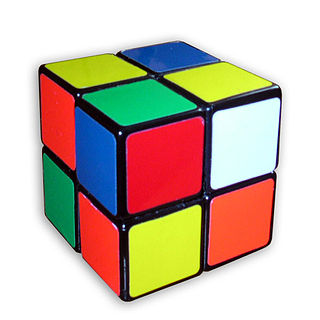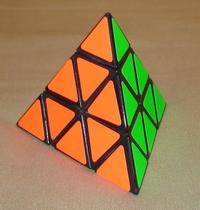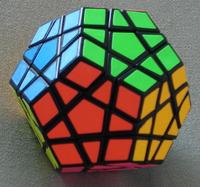
The Rubik's Cube is a 3D combination puzzle invented in 1974 by Hungarian sculptor and professor of architecture Ernő Rubik. Originally called the Magic Cube, the puzzle was licensed by Rubik to be sold by Pentangle Puzzles in the UK in 1978, and then by Ideal Toy Corp in 1980 via businessman Tibor Laczi and Seven Towns founder Tom Kremer. The cube was released internationally in 1980 and became one of the most recognized icons in popular culture. It won the 1980 German Game of the Year special award for Best Puzzle. As of January 2024, around 500 million cubes had been sold worldwide, making it the world's bestselling puzzle game and bestselling toy. The Rubik's Cube was inducted into the US National Toy Hall of Fame in 2014.

The Rubik's Revenge is a 4×4×4 version of the Rubik's Cube. It was released in 1981. Invented by Péter Sebestény, the cube was nearly called the Sebestény Cube until a somewhat last-minute decision changed the puzzle's name to attract fans of the original Rubik's Cube. Unlike the original puzzle, it has no fixed faces: the center faces are free to move to different positions.

The Pocket Cube is a 2×2×2 combination puzzle invented in 1970 by American puzzle designer Larry D. Nichols. The cube consists of 8 pieces, which are all corners.

The Pyraminx is a regular tetrahedron puzzle in the style of Rubik's Cube. It was made and patented by Uwe Mèffert after the original 3 layered Rubik's Cube by Ernő Rubik, and introduced by Tomy Toys of Japan in 1981.

David Breyer Singmaster was an American-British mathematician who was emeritus professor of mathematics at London South Bank University, England. He had a huge personal collection of mechanical puzzles and books of brain teasers. He was most famous for being an early adopter and enthusiastic promoter of the Rubik's Cube. His Notes on Rubik's "Magic Cube" which he began compiling in 1979 provided the first mathematical analysis of the Cube as well as providing one of the first published solutions. The book contained his cube notation which allowed the recording of Rubik's Cube moves, and which quickly became the standard.

The Megaminx or Mégaminx is a dodecahedron-shaped puzzle similar to the Rubik's Cube. It has a total of 50 movable pieces to rearrange, compared to the 20 movable pieces of the Rubik's Cube.

Uwe Mèffert was a German puzzle designer and inventor. He manufactured and sold mechanical puzzles in the style of Rubik's Cube since the Cube craze of the 1980s. His first design was the Pyraminx – which he had developed before the original Rubik's Cube was invented. He created his own puzzle company and helped bring to market the Megaminx, Skewb, Skewb Diamond and many other puzzles.

A combination puzzle, also known as a sequential move puzzle, is a puzzle which consists of a set of pieces which can be manipulated into different combinations by a group of operations. Many such puzzles are mechanical puzzles of polyhedral shape, consisting of multiple layers of pieces along each axis which can rotate independently of each other. Collectively known as twisty puzzles, the archetype of this kind of puzzle is the Rubik's Cube. Each rotating side is usually marked with different colours, intended to be scrambled, then solved by a sequence of moves that sort the facets by colour. Generally, combination puzzles also include mathematically defined examples that have not been, or are impossible to, physically construct.

The Rubik's Cube is the original and best known of the three-dimensional sequential move puzzles. There have been many virtual implementations of this puzzle in software. It is a natural extension to create sequential move puzzles in more than three dimensions. Although no such puzzle could ever be physically constructed, the rules of how they operate are quite rigorously defined mathematically and are analogous to the rules found in three-dimensional geometry. Hence, they can be simulated by software. As with the mechanical sequential move puzzles, there are records for solvers, although not yet the same degree of competitive organisation.
Eric Limeback is a Canadian speedcuber. He is known for his 11/11 3x3x3 multiblindfold Canadian record solve, as well as his standard 3x3x3 blindfolded solving. Limeback was the first Canadian to record a sub-30 second official 3x3x3 blindfolded solve. Limeback began solving the Rubik's Cube in 9th grade. He graduated from Marc Garneau Collegiate Institute in 2010. He formerly held the Guinness World Record for the most 3x3x3 cubes solved in 24 hours, 5800, set from 3–4 October 2013 at Wilfrid Laurier University, Canada.

Rubik's Puzzle World, known as Rubik's World in North America, is a puzzle video game for the Wii and Nintendo DS platforms developed by Two Tribes and published by The Game Factory. The video game features the famous Rubik's Cube, originally designed by the Hungarian inventor Ernő Rubik. The game contains the likeness of the cube as well as a playable version of the Rubik's Cube, as well as multiple puzzle game modes involving the Cube's constituent parts, known as "Cubies".

Rubik's Domino is a hand-held puzzle similar to a Rubik's Cube. However, it has one layer removed, making it a 2×3×3 cuboid. The 3×3 faces can be turned 90-degrees as normal, but the 2×3 faces can only be turned 180 degrees. Other cuboids of 2×2×n will solve like multiple dominoes at once. When only using pairs of turns, the puzzle may be solved similarly to a 3x3. The original version had white and black plastic layers. Each 3×3 face displayed a number of dots from 1–9. More recent versions use the traditional six-colour scheme, as seen on most other twisty puzzles. It has 406,425,600 potential positions and any position can be made into a solved position in 19 moves. It was registered as US Patent number 4378116 on 29 March 1983 by Ernő Rubik.
The original Rubik's cube was a mechanical 3×3×3 cube puzzle invented in 1974 by the Hungarian sculptor and professor of architecture Ernő Rubik. Extensions of the Rubik's cube have been around for a long time and come in both hardware and software forms. The major extension have been the availability of cubes of larger size and the availability of the more complex cubes with marked centres. The properties of Rubik’s family cubes of any size together with some special attention to software cubes is the main focus of this article. Many properties are mathematical in nature and are functions of the cube size variable.
Katsuhiko Okamoto is a Japanese inventor who specializes in modifications of the Rubik's Cube. Since 2001 he has created 31 such puzzles.
Panagiotis Verdes is a Greek inventor and is known for being the first person to mass produce 6x6x6 puzzles and 7x7x7 twisty puzzles. He is also known for founding the company V-Cube. He has also worked on new designs of every Twisty Puzzle from 2x2x2 to 11x11x11.

Oskar van Deventer is a Dutch puzzle maker. He prototypes puzzles using 3D printing. His work combines mathematics, physics, and design, and he collaborates at academic institutions. Many of his combination puzzles are in mass production by Uwe Mèffert and WitEden. Oskar van Deventer has also designed puzzles for Hanayama.

The Gear Cube is a 3-D combination puzzle designed and created by Dutch puzzle maker Oskar van Deventer based on an idea by Bram Cohen. It was initially produced by Shapeways in 2009 and known as "Caution Cube" due to the likelihood of getting one's fingers stuck between the gears while speedcubing. Later, in 2010, it was mass-produced by Meffert's as the "Gear Cube".

The Mirror Blocks, also known as the Mirror Cube and Bump Cube, is a type of combination puzzle and shape modification of the standard 3×3×3 Rubik's Cube and was invented in 2006. The puzzle's internal mechanism is nearly identical to that of the Rubik's Cube, although it differs from normal 3×3 cubes in that all pieces are the same color and are identified by shape since each one is also a distinct rectangular prism. Like the Ghost Cube and Mastermorphix, the Mirror Blocks has a 3×3×3 shape, meaning that it can be solved the same way as the 3×3×3 Rubik's Cube. The fastest single solve for Mirror Blocks in a competition is 10.07 seconds and was achieved by Braden Richards in Huntington, West Virginia on May 17, 2024.

The Dino Cube is a cubic twisty puzzle in the style of the Rubik's Cube. It was invented in 1985 by Robert Webb, though it was not mass-produced until ten years later. It has a total of 12 external movable pieces to rearrange, compared to 20 movable pieces on the Rubik's Cube.

Prithveesh K. Bhat or Prathvish K. Bhat is an Indian Rubik's Cube speedcuber and mosaic artist. He has set several Rubik's Cube records, including two Guinness World Records namely ′Largest Dual Sided Rubik’s Cube Mosaic′, leading a team of 20 members and ′Most contributions to a Rubik's cube mosaic′, leading a team of 293 people.
















